Cupra Terramar Review 2025
Cupra Terramar At A Glance
A Terra what? Spanish racing fans will tell you that the Cupra Terramar is named after the old banked racing circuit to the west of Barcelona. It might seem odd naming a family SUV after a race track but then Cupra's whole branding is geared towards sportiness — and after all, one of the best-selling cars of this type, the Terramar's Volkswagen Tiguan close cousin, is named after a German language mash-up of 'tiger' and 'iguana', which hasn't held it back. Find out how the Spanish newcomer stacks up in our full Cupra Terramar review.
The Cupra Terramar sits on the same underpinnings as the latest Volkswagen Tiguan but while VW has played it safe with its car's styling, the Terramar is much more imposing for a family SUV, especially if you opt for one of the faster VZ-specification models.
The result is a car with a more aggressive aesthetic than its relative, with a bolder look following through to its interior. The metallic trim that's finished in the brand's copper hue stands out against the dark colour schemes of the Cupra Terramar's moodier finishes.
What's similar to the Tiguan, though, is the level of technology and equipment on offer. You'll find a large infotainment touchscreen, loads of driver assistance aids and an array of other conveniences as standard. As it shares much of its understructure with the Tiguan, the Cupra Terramar also does well in the practicality stakes, although the VW just edges it here.
With such sporty intentions, it won't come as a surprise to discover that there's no diesel option available forthe Cupra Terramar. There are three petrol engines, ranging from a not-so-sporty 1.5-litre option with 150PS and mild hybrid-assistance, to a 2.0-litre turbocharged engine with 265PS that's been borrowed from the Volkswagen Golf GTI.
On top of that are a couple of plug-in hybrid options, delivering around 70 miles of electric driving range each, making them a good option for those undetaking regular, shorter journeys and have access to a wallbox charger at home or work.
It's all well and good selling the sporty SUV lifestyle but does the Cupra Terramar back this up on the road? To a point, yes. It's still a family SUV at the end of the day but the handling is that bit sharper than the Tiguan's, with precise steering that's really well-weighted to deliver an enjoyable drive.
Cupra Terramar handling and engines
Cupra Terramar 2025: Handling and ride quality
Lower down the range and both the Terramar V1 and V2 come on standard, non-adaptive sports suspension. The V1s sit on smaller alloy wheels with a higher side wall than the others, which should help with ride comfort. Interestingly, compared with the similar VW Tiguan, V1 and V2 Terramars sit 10mm lower.
In the e-Hybrid models the extra weight of the batteries means the adaptive dampers have to do a lot of heavy lifting to avoid making the ride too firm. Petrol-only versions feel a bit more forgiving, delivering a smoother, comfier ride.
It also changes direction nicely for a family SUV. There's a good amount of traction on offer, with body lean well-controlled. The steering is beautifully weighted and responsive, meaning you feel connected to the car.
You'll want to plump for the PHEV version if refinement is one of your main criteria. It goes without saying that under electric power alone it's incredibly quiet when trundling around. Just as impressively, though, is the fact that provided you keep throttle inputs gentle, it can run on its batteries up to 87mph.
Even when the engine does kick in it's not that audible. It's only when you stab the accelerator that it sounds rather loud and strained. The smoother power delivery of either the 2.0-litre TSI petrols mean they are the ones to go for if you want more effortless progress.
And on the road, wind and tyre noise aren't the quietest but at the same time they don't distract from the drive either.
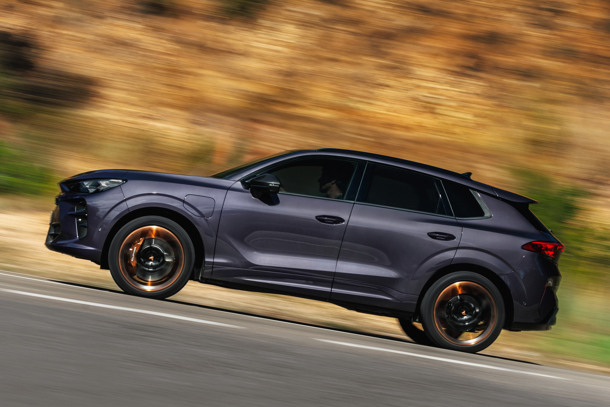
Cupra Terramar 2025: Engines
You won't find a diesel engine in the Cupra Terramar range but there's a decent choice of petrol and plug-in hybrid options to choose from.
The entry point in the range is the 1.5-litre petrol engine with 150PS and 250Nm of torque. Badged eTSI, it comes with mild hybrid technology to boost fuel economy and delivers a 0-62mph time of 9.3 seconds.
If that sounds a little too sedate for your sporty SUV, then you might want to look at the more powerful 2.0-litre turbocharged petrol engine with 204PS and 320Nm available plus 4Drive four-wheel drive. This sees the 0-62 time come down to 7.1 seconds, but you'll want the more powerful 265PS/400Nm version borrowed from the Volkswagen Golf GTI if you want something really quick. This pushes you on to 62mph from a standstill in as little a 5.9 seconds.
If none of those tickle your fancy, then you've also got two PHEVs to choose from. Called e-Hybrid, both combine a 1.5-litre four-cylinder petrol engine with an electric motor, but come with different power outputs and performance figures.
The 204PS version has a modest 0-62mph time of 8.3 seconds, but working in its favour is the claimed range of up to 73 miles. With lots of rivals just creeping into the 50-mile bracket, it's a real bonus with the Cupra Terramar.
Delivering up to 72 miles of electric driving is the 272PS option. When we say quicker, you might see that power output and expect it to beat the 2.0-litre TSI 265PS in the 0-62mph stakes but it's slower at 7.3 seconds. This is down to the extra weight of the batteries onboard and only being front-wheel drive — as such, it can feel a bit more leisurely to drive, but should be quick enough for most customers.
Cupra Terramar 2025: Safety
The Cupra Terramar was crash-tested by safety organisation Euro NCAP and scored the full five stars. Drilling down the scores and it got high marks for adult occupant safety (89%), child occupant safety (87%) and for protection of vulnerable road users (82%).
The Terramar comes with seven airbags as standard, while it's also equipped with a range of semi-autonomous driver aids to help keep you safe. This includes automatic emergency braking, lane-assist, dynamic road sign display and adaptive cruise control as standard across the range.
Both V2 and VZ2 trims add a few more safety features — you benefit from an advanced driver alert system, advanced lane assist, traffic jam assist, blind-spot monitoring, and rear cross-traffic assist.
Cupra Terramar 2025: Towing
The Cupra Terramar can be specified with a collapsible tow bar. How heavy a braked trailer it can tow varies with the engine choice, yet despite the lack of a diesel choice all of the figures are respectable.
It's rated up to 1800kg when fitted with the 1.5-litre eTSI 150PS and 1.5-litre e-Hybrid 204PS engines, while the 272PS e-Hybrid increases that to 2000kg.
Both the 204PS and 265PS 2.0-litre TSI 4Drive Terramars see this increase to 2200kg.
Cupra Terramar interior
Cupra Terramar 2025: Practicality
If you're trying to place the size of the Cupra Terramar, then with its dimensions of 4519mm long, 1869mm wide (without door mirrors) and 1584mm tall, it's similar in size to the VW Tiguan and a bit longer than the Volvo XC40, though not quite as tall.
That all means that it should suit a family of four. The sports seats up front are standard and hug you nicely, with the central console hemming you in to to make you feel properly snug and connected to the car. There's still a good amount of storage space, with large door pockets and cupholders in the middle.
How much space you have for passengers in the back is dependent on how much boot space you need. That's because the rear bench seat can be moved forward to create more boot space if you need it. The Cupra Terramar's boot capacity is 540 litres when the seats are pushed back but slide them forwards and this grows to 642 litres. That's a decent size and significantly more than the 443 litres provided by the Volvo XC40, but 10 litres down on the VW Tiguan.
If you're looking at buying the plug-in hybrid version of the Cupra Terramar, then those boot capacity figures are different due to the need to find somewhere to put the batteries that power the motors. As a result, boot space for the Cupra Terramar PHEV is between 400 and 490 litres, depending on the positioning of the rear seats.
Back to the rear seating and with the bench seat pushed back and there's a generous amount for head and legroom — tall adults shouldn't feel squeezed, but we would avoid trying to get a third person in the back. It's certainly possible, but the seat's narrower and their legs will straddle the hump in the middle of the floor.
Push the seats forward by 150mm and you obviously lose out on legroom, but if it's going to be a family car then young children in car seats shouldn't really notice. There are Isofix fastenings on the two outer rear seats.
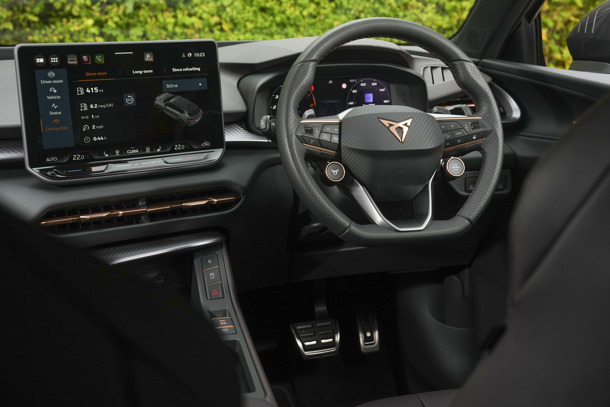
Cupra Terramar 2025: Quality and finish
The quality of finish is one of the things that left a really good impression on us about the Cupra Terramar. Most of the materials in the front of the cabin feel really nice, especially the key touch points. You'll notice plenty of squidgy, cushioned surfaces rather than hard plastic trim, while the various metallic-look elements add to the overall feel.
The only disappointment is for those sitting in the back — look closer and the plastics aren't of the same grade as they are up front. They certainly don't feel cheap but they are a letdown in comparison.
Cupra Terramar 2025: Infotainment
Whatever trim level you choose, all versions of the Cupra Terramar get the same infotainment system as standard. That means you get a 12.9-inch touchscreen positioned front and centre of the dashboard. The display itself has very good clarity and vibrant graphics, while it proved to be nice and responsive to our inputs.
The interface itself is cluttered and hard to navigate at first — you will spend time trying to track down some functions and settings. The climate control settings are also set via the touchscreen and while we'd always prefer physical buttons to operate this, the display is responsive enough to make it easy to do on the move.
There's also all the other usual stuff including DAB radio, Bluetooth connectivity plus Apple CarPlay and Android Auto, which we envisage a lot of users taking advantage of, though there is built-in navigation if you need it.
Supporting this large touchscreen is a 10.25-inch digital instrument display sat behind the steering wheel that shows key driving info and can be tailored on V2 and VZ2 models to show different information, such as turn-by-turn directions if you wish.
Cupra Terramar value for money
Cupra Terramar 2025: Prices
Prices for the Cupra Terramar start at £38,995, which gets you the entry-level V1 model with the 1.5-litre eTSI 150PS engine. If you fancy the more powerful 2.0-litre TSI 204PS petrol with four-wheel drive then it's a jump to £43,460, while the 1.5-litre e-Hybrid 204PS PHEV is £44,535. The move up to the V2 trim is an extra £2660 for each engine.
For the Cupra Terramar VZ1 you'll need £47,410 for the 1.5-litre e-Hybrid 272PS PHEV and £47,855 for the petrol-only 2.0-litre TSI 265PS with four-wheel drive. Sitting at the top of the range is the Terramar VZ2 specification for an extra £2740 with both engine choices.
How do those prices compare with rivals? The closely related VW Tiguan starts at £38,080 and comes with the same 1.5-litre eTSI 150PS petrol engine. There's a wide choice of trim and engine combinations but as you move up the range, the cost of the Volkswagen leapfrogs the Cupra — the Tiguan R-Line with the 272PS plug-in hybrid is £48,485, placing it just over £1000 more than the Terramar VZ1. If you fancy the 265PS petrol-engined Tiguan in top-of-the-range Black Edition trim, prepare to spend £52,440 which edges out the Terramar VZ2 by £1845.
Looking further afield and the Volvo XC40 starts at £36,840 in Core trim with the B3 (P) mild hybrid petrol, though in Plus grade it's £40,090, and more evenly matched to the Terramar V1. With only two engines to choose from, you're not going to be able to match the more powerful Terramars but the 197PS XC40 B4 (P) in Ultra Black Edition specification comes in at £47,710.
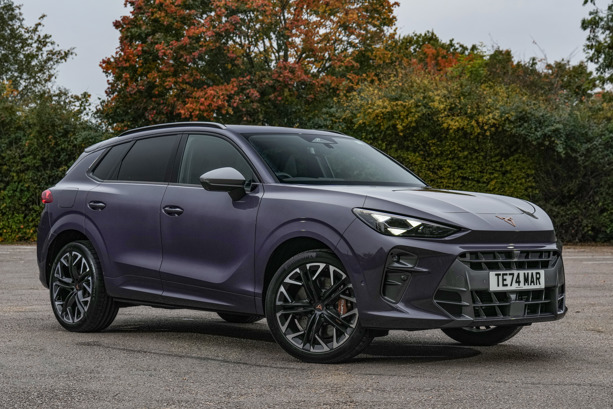
Cupra Terramar 2025: Running Costs
The most frugal petrol engine in the Cupra Terramar range is the 1.5-litre eTSI 150PS offering up to 47.1mpg according to the WLTP official tests, while the four-wheel drive 2.0-litre TSI 204PS sees this dip to a more modest 37.7mpg best. It goes without saying that the 265PS petrol engine in the Terramar VZ1 and VZ2 has fuel economy closer to that of a hot hatch, averaging a high of 33.6mpg
If fuel economy is your prime concern, then you need to look at one of the plug-in hybrid options. Both the 1.5-litre e-Hybrid 204PS and 272PS models officially deliver up to 176.6mpg, depending on the version chosen. As with other PHEVs, this comes with a caveat — to get anywhere near the number, you'll need to keep the battery topped up, so regular charging is essential. That said, the Benefit-in-Kind (BiK) tax rate for company car drivers is only 6%, rising to 9% for the VZ2 e-Hybrid 272PS only.
As for car insurance and the Terramar V1 1.5-litre eTSI 150PS starts in group 21E, while the VZ2 2.0-litre TSI 4Drive 265PS will set you back the most, falling into group 33E.
Regardless of which model you choose, you'll be paying the same £195 annually for Vehicle Excise Duty (VED or car tax) whether you have a plug-in hybrid or petrol Terramar. Only the entry-level Terramar comes in under £40,000, meaning all of the others will incur an additional surcharge of £425 from years two to six due to the Expensive Car Supplement, bringing your total annual tax cost to £620 at today's rates.
Unlike a lot of other Volkswagen Group brands, Cupra offers a five-year/90,000-mile warranty, the first two years of which come with unlimited mileage. That's an extra two years and 30,000 miles of cover compared with the VW Tiguan. That said, it can't match the excellent seven-year/100,000-mile warranty provided with the Kia Sportage.
Satisfaction Index
 What is your car like to live with?
What is your car like to live with?
We need your help with our latest Satisfaction Index, so that we can help others make a smarter car buying decision. What's it like to live with your car? Love it? Loath it? We want to know. Let us know about your car - it will only take a few minutes and you could be helping thousands of others.
Help us with the Honest John Satisfaction Index nowCupra Terramar models and specs
There is a range of four trim levels available with the Cupra Terrarmar — V1, V2, VZ1 and VZ2. Those prefixed VZ are exclusively available with the two most powerful engine choices.
The Cupra Terrarmar V1 comes with the following as standard:
- 18-inch alloy wheels
- LED exterior lighting
- Automatic lights and wipers
- Heated and electrically foldable door mirrors
- Front and rear parking sensors
- Reversing camera
- Keyless entry and start
- Ambient interior lighting
- Three-zone climate control
- Heated leather steering wheel
- Bucket seats
- Powered tailgate
- Adaptive cruise control
- 12.9-inch multimedia touchscreen
Next up is the Cupra Terrarmar V2 adding:
- 19-inch alloy wheels
- Heated bucket seats
- Head-up display
- Top-view camera
Jumping up to the Cupra Terrarmar VZ1, its highlights include:
- Heated and powered front seats trimmed in faux-suede
- Self-adjusting high-definition LED Matrix headlights
- Dynamic Chassis Control adaptive suspension
Sitting at the top of the range is the Cupra Terramar VZ2 which gains:
- 20-inch alloy wheels
- Heated and powered leather front seats
- Head-up display
- Top-view camera

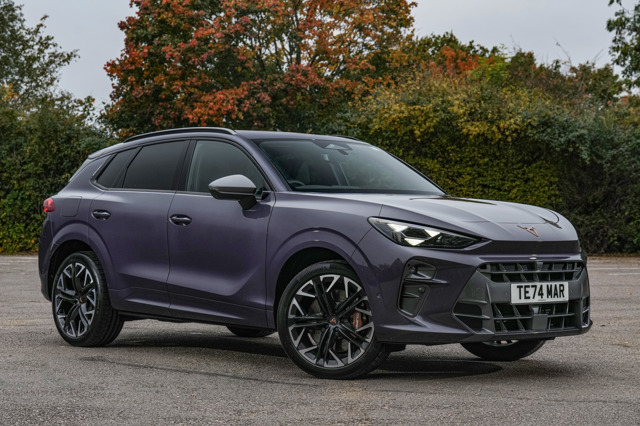
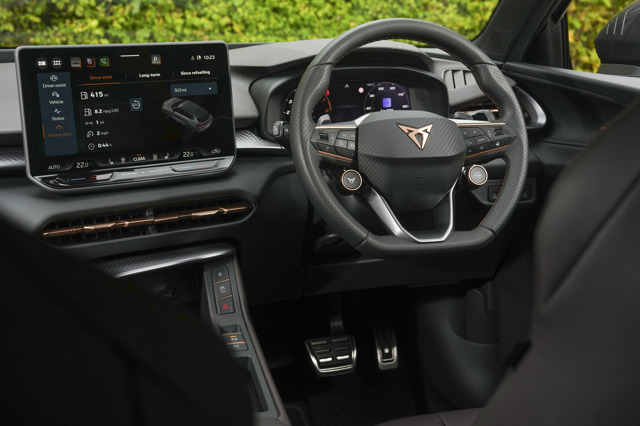
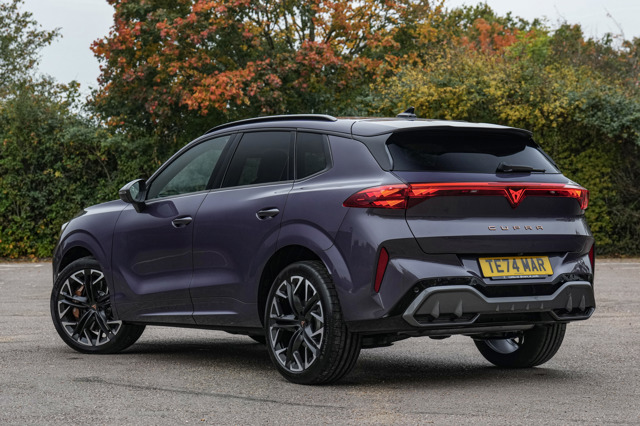
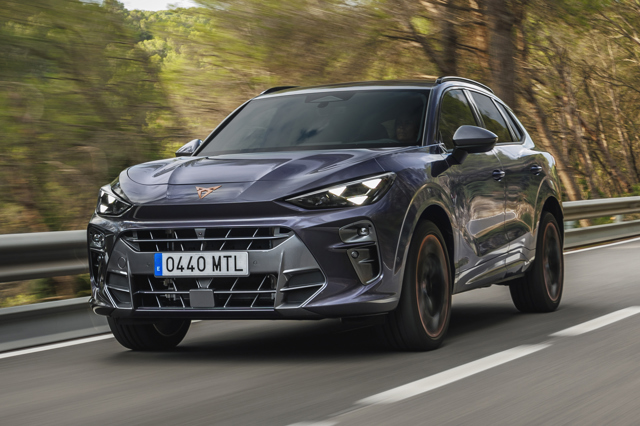
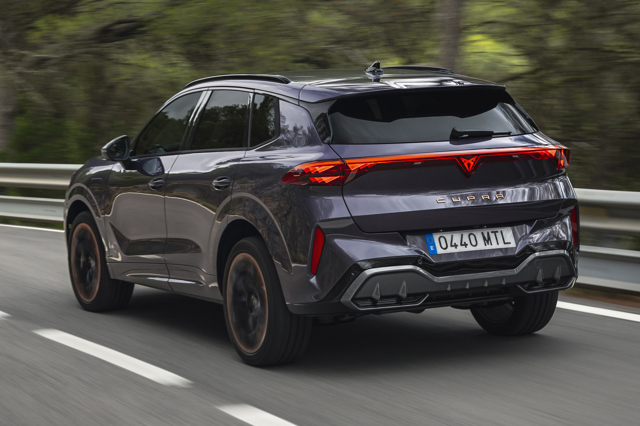
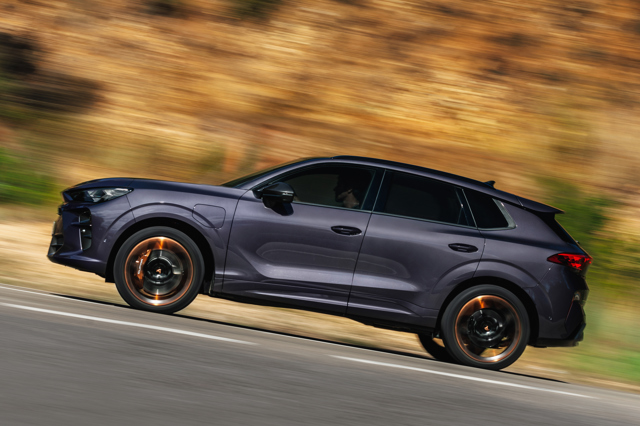
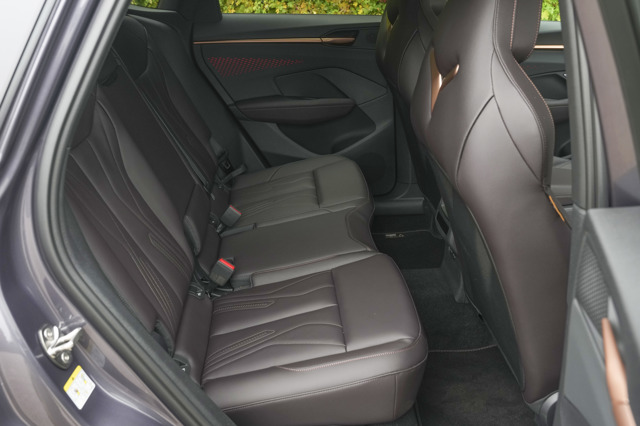
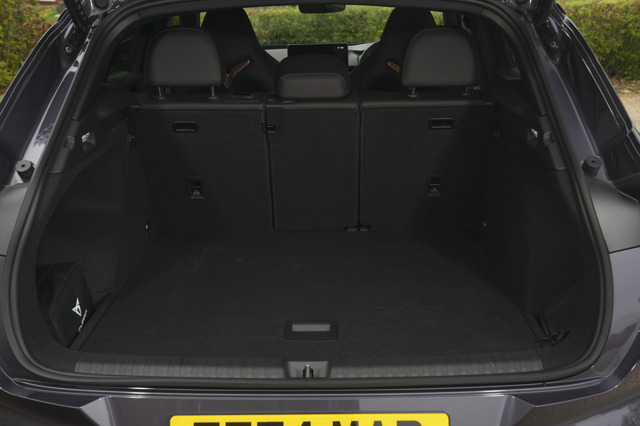
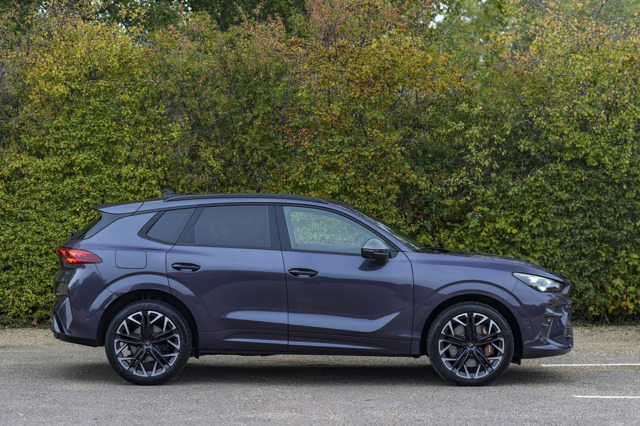


 Stands out compared with rivals. All versions are well equipped. Good to drive. PHEVs have great range.
Stands out compared with rivals. All versions are well equipped. Good to drive. PHEVs have great range.
 Infotainment could be a bit more refined. Only top-spec cars come with adaptive dampers.
Infotainment could be a bit more refined. Only top-spec cars come with adaptive dampers.




